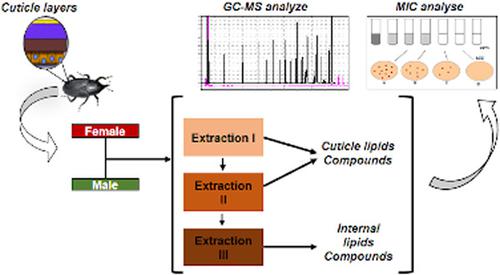当前位置:
X-MOL 学术
›
Arch. Insect Biochem. Physiol.
›
论文详情
Our official English website, www.x-mol.net, welcomes your
feedback! (Note: you will need to create a separate account there.)
Chemical composition and antimicrobial activity of cuticular and internal lipids of the insect Rhynchophorus palmarum.
Archives of Insect Biochemistry and Physiology ( IF 1.5 ) Pub Date : 2020-07-05 , DOI: 10.1002/arch.21723 Mariana de M C Batalha 1 , Henrique F Goulart 2 , Antônio E G Santana 2 , Leandro A O Barbosa 3 , Ticiano G Nascimento 1 , Meirielly K H da Silva 1 , Camila B Dornelas 1 , Luciano A M Grillo 1
Archives of Insect Biochemistry and Physiology ( IF 1.5 ) Pub Date : 2020-07-05 , DOI: 10.1002/arch.21723 Mariana de M C Batalha 1 , Henrique F Goulart 2 , Antônio E G Santana 2 , Leandro A O Barbosa 3 , Ticiano G Nascimento 1 , Meirielly K H da Silva 1 , Camila B Dornelas 1 , Luciano A M Grillo 1
Affiliation

|
Insect cuticle lipids are involved in various types of chemical communication between species, and reduce the penetration of insecticides, chemicals, and toxins, as well as provide protection against the attack of microorganisms, parasitic insects, and predators. Ecological studies related to the insect Rhynchophorus palmarum are well‐known; however, very little is known about its resistance mechanisms, which includes its lipid composition and its importance, specifically the cuticle layer. This study aimed to characterize the cuticle and internal lipid compounds of the male and female R. palmarum adult insects and to evaluate the presence of antimicrobial activity. We performed by gas chromatography coupled to mass spectrometry (GC–MS) analyzes of lipid extracts fractions and we identified 10 methyl esters of fatty acids esters of C14 to C23, with variation between the sexes of C22:0, C21:0, present only in male cuticle, and C20:2 in female. The lipid content of this insect showed relevant amount of C16:1, C18:1, and C18:2. The antimicrobial activity of the cuticular and internal fractions obtained was tested, which resulted in minimum inhibitory concentrations between 12.5 and 20 μg/ml against Gram‐positive bacteria (Staphylococcus epidermidis, Enterococcus faecalis), Gram‐negative (Pseudomonas aeruginosa, Escherichia coli, Klebsiella pneumonia), and fungal species (Candida albicans e Candida tropicalis). The antimicrobial effect of the R. palmarum cuticle open perspectives for a new source to bioinsecticidal strategies, in addition to elucidating a bioactive mixture against bacteria and fungi.
中文翻译:

昆虫掌心蓝藻的表皮和内部脂质的化学组成和抗菌活性。
昆虫表皮脂质参与物种之间的各种类型的化学通讯,并减少杀虫剂,化学物质和毒素的渗透,并提供针对微生物,寄生虫和捕食者的攻击的保护。与昆虫棕榈毛虫相关的生态学研究是众所周知的。然而,对其抗药性机制知之甚少,其中包括其脂质组成及其重要性,尤其是表皮层。这项研究旨在表征男性和女性棕榈树的表皮和内部脂质化合物成虫并评估其抗菌活性的存在。我们通过气相色谱与脂质提取物组分的质谱分析(GC-MS)进行了分析,我们确定了C14至C23的脂肪酸酯的10个甲基酯,其中C22:0,C21:0的性别之间存在差异在男性角质层中,C20:2在女性中。该昆虫的脂质含量显示C16:1,C18:1和C18:2的相关含量。测试了所获得的表皮和内部级分的抗菌活性,这导致对革兰氏阳性菌(表皮葡萄球菌,粪肠球菌),革兰氏阴性菌(铜绿假单胞菌,大肠杆菌,肺炎克雷伯菌和真菌种类(白色念珠菌和热带念珠菌)。的的抗菌效果R. palmarum毛鳞片打开透视新源生物杀虫策略,除了阐明对细菌和真菌生物活性混合物。
更新日期:2020-07-05
中文翻译:

昆虫掌心蓝藻的表皮和内部脂质的化学组成和抗菌活性。
昆虫表皮脂质参与物种之间的各种类型的化学通讯,并减少杀虫剂,化学物质和毒素的渗透,并提供针对微生物,寄生虫和捕食者的攻击的保护。与昆虫棕榈毛虫相关的生态学研究是众所周知的。然而,对其抗药性机制知之甚少,其中包括其脂质组成及其重要性,尤其是表皮层。这项研究旨在表征男性和女性棕榈树的表皮和内部脂质化合物成虫并评估其抗菌活性的存在。我们通过气相色谱与脂质提取物组分的质谱分析(GC-MS)进行了分析,我们确定了C14至C23的脂肪酸酯的10个甲基酯,其中C22:0,C21:0的性别之间存在差异在男性角质层中,C20:2在女性中。该昆虫的脂质含量显示C16:1,C18:1和C18:2的相关含量。测试了所获得的表皮和内部级分的抗菌活性,这导致对革兰氏阳性菌(表皮葡萄球菌,粪肠球菌),革兰氏阴性菌(铜绿假单胞菌,大肠杆菌,肺炎克雷伯菌和真菌种类(白色念珠菌和热带念珠菌)。的的抗菌效果R. palmarum毛鳞片打开透视新源生物杀虫策略,除了阐明对细菌和真菌生物活性混合物。









































 京公网安备 11010802027423号
京公网安备 11010802027423号